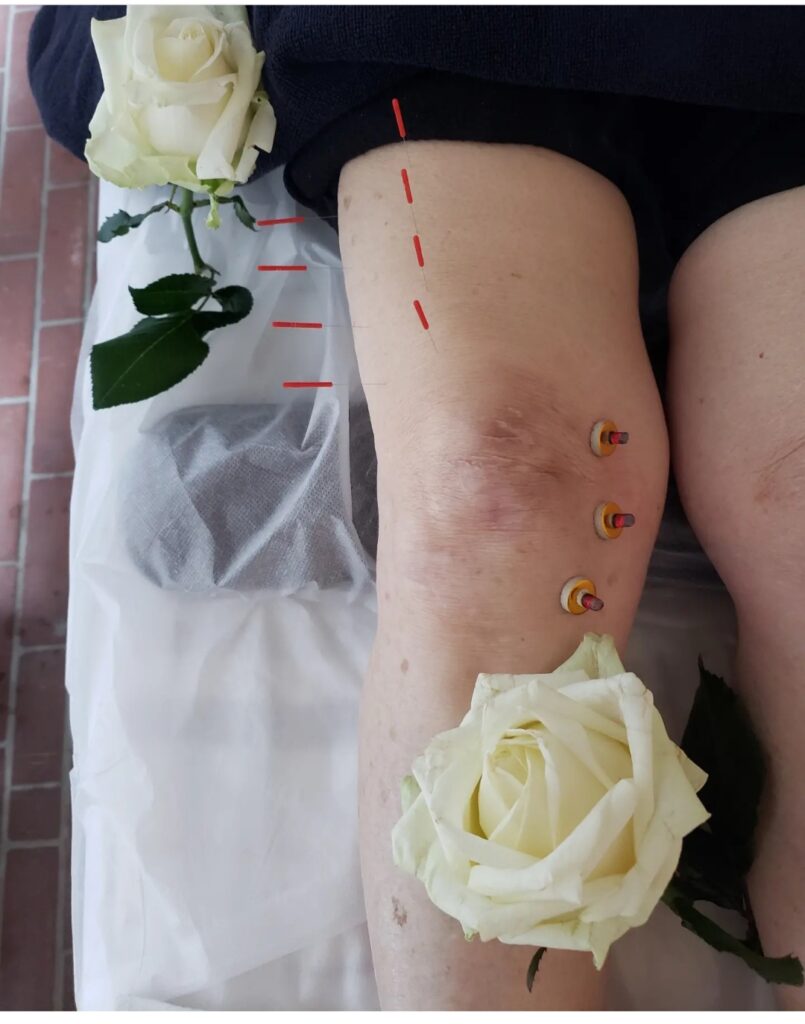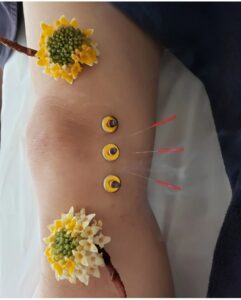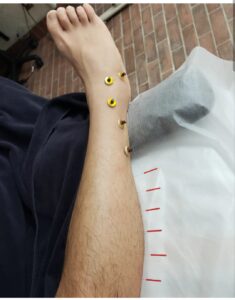膝 内側側副靭帯損傷 太股が硬い
Knee Medial collateral ligament injury Stiff thigh
膝関節は大腿骨(太ももの骨)と、脛骨(すねの骨)、膝蓋骨(膝のお皿)の3つの骨で構成されています。大腿骨(太ももの骨)と脛骨(すねの骨)がグラグラしないように前十字靭帯、後十字靭帯、内側側副靱帯、外側側副靱帯の4つの靱帯で、つながっています。これらの靱帯が強い力が加わって、伸びたり切れたりした状態を膝の靱帯損傷といい、膝に加わった力の向きによって損傷する靭帯が変わります。内側・外側側副靱帯は膝関節の両側にあり、膝の左右の動きを抑えて、膝関節の安定性を高めています。内側側副靭帯は、内側側副靭帯・MCLは浅層、深層、後斜靱帯の3層構造となっていて、長さ10cm、幅3cmの範囲で膝関節内側部の大腿骨内側(大腿骨内上顆)から脛骨内側部(すねの骨)にかけて走行しています。膝内側側副靱帯(MCL)は、膝靱帯損傷のうちで損傷する頻度が高いです。初期に適切に処置をすれば修復しやすいです。しかし陳旧化(急性期に処置をせず伸びたままの状態で放置)した場合は、予後が悪くなり、膝関節の他の靭帯や軟骨、前十字靭帯や半月板損傷などの合併症を誘発したりします。症例写真では、膝の怪我の痛みが治まったので放置したところ、膝の内側の痛みと、太ももに硬さがでてきてしまい、膝関節が曲がりにくくなっていました。内側側副靭帯損傷の検査法で、内側を引き延ばす、内反ストレス方があります。膝を伸ばしても痛いのか、膝を屈曲時のみ痛いのかで、重症度も違います。鍼灸治療では人間が持つ傷の修復・回復作用を利用して、痛みにより固まった筋肉の緊張を緩和させ、さらに免疫を高めていきます。人間は、体に傷を負うと修復しようとして、血液循環が促進されるのですが、鍼灸では鍼やお灸を使い、あえて微細な傷を作り出すことで、血流を改善させ、血行を促進、血液循環を促し、内側側副靭帯周囲の疼痛と緩和をしていきます。みずらからの回復機能をあげることで、免疫強化をしているのです。また、お灸のの原料となっているのはもぐさは、さまざまな効果のある薬草で、食物繊維、クロロフィル(葉緑素)、ミネラルを含みます。浄血、増血作用のほか、止血作用もあります。お灸で体に温熱刺激を与えることで、皮膚の下にある筋肉や血管、リンパ節が刺激され、細胞が活性化、免疫作用が高まり、リンパの流れが改善され、余分な水分や老廃物が回収、むくみの解消にもつながります。
The knee joint consists of three bones: the femur (thigh bone), tibia (shin bone), and patella (knee plate). The femur (thigh bone) and tibia (shin bone) are connected by four ligaments, the anterior cruciate ligament, posterior cruciate ligament, medial collateral ligament, and lateral collateral ligament, to prevent wobble. When these ligaments are stretched or torn by strong force, it is called knee ligament injury, and the ligament that is damaged depends on the direction of the force applied to the knee. The medial and lateral collateral ligaments are located on both sides of the knee joint, and they control the side-to-side movement of the knee and increase the stability of the knee joint. The medial collateral ligament, MCL, is composed of three layers, the shallow, deep, and posterior oblique ligaments, and is 10 cm long and 3 cm wide, running from the medial femur (medial femoral epicondyle) to the medial tibia (shin bone) on the medial side of the knee joint. The medial collateral ligament (MCL) is the most frequently injured knee ligament. It is easily repaired if properly treated in the early stages. However, if it is left in a state of deterioration (left stretched without treatment in the acute phase), the prognosis is poor and can induce complications such as damage to other ligaments and cartilage in the knee joint, the anterior cruciate ligament, or the meniscus. In the case photo, the pain from the knee injury had subsided and was left untreated, resulting in pain in the medial knee and stiffness in the thigh, which made it difficult to bend the knee joint. There is a method of testing for medial collateral ligament injuries that involves medial stretching and internal stressing. The severity of the pain differs depending on whether it hurts when the knee is extended or only when the knee is flexed. Acupuncture treatment uses the human body's ability to repair and heal wounds to relieve muscle tension that has been stiffened by pain and further enhance the immune system. When the human body is injured, blood circulation is stimulated to repair the damage. Acupuncture and moxibustion use needles and moxibustion to create minute wounds to improve blood flow, promote blood circulation, and relieve pain and pain around the medial collateral ligament. By improving the recovery function of the body, it strengthens the immune system. Moxa, the material used in moxibustion, is a medicinal herb with various effects, including dietary fiber, chlorophyll (chlorophyll), and minerals. It has the effects of purifying blood, increasing blood volume, and stopping bleeding. By stimulating the body with moxibustion, the muscles, blood vessels, and lymph nodes under the skin are stimulated, cells are activated, immune function is enhanced, lymphatic flow is improved, excess water and waste are collected, and swelling is reduced!



